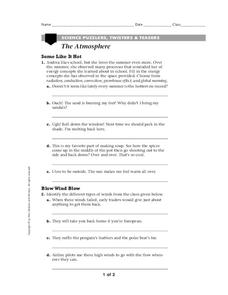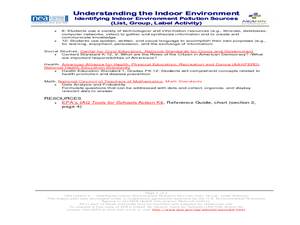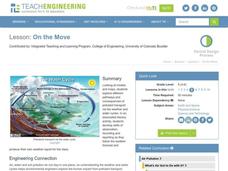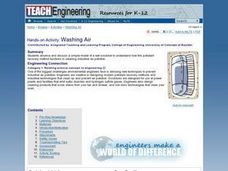Curated OER
Acid Rain
Create a simulation of acid rain in your classroom with lemon juice and bean plants to help kids study the effects of pollution on plants. In addition, learners will listen to a story and write responses based on guiding questions.
Curated OER
Benefits of Indoor Plants
Students diagram a plant. In this Science lesson, students explore the concept of photosynthesis focusing on the oxygen production. Students calculate the amount of plants needed to filter the air in their classroom.
Curated OER
Clearing the Air
Students learn to recognize air as an actual substance and come to understand that clean air is important and why. They become aware of adverse effects that air pollution can cause and examine how simple steps can be used to keep our air...
Curated OER
Acid (and Base) Rainbows
Students are introduced to the differences between acids and bases and how to use indicators, such as pH paper and red cabbage juice, to distinguish between them. They make predictions that can be answered through scientific...
Core Knowledge Foundation
Taking Care of the Earth Tell It Again!™ Read-Aloud Anthology
A read-aloud anthology closely examines human impact on the Earth while boosting reading comprehension skills. Through stories, scholars examine the concepts of natural resources, pollution, garbage, and recycling and brainstorm...
Texas Commission on Environmental Quality
Environmental Sciences
Whether you are teaching environmental science in junior high or studying recycling in kindergarten, there is something for all in this set of lessons designed for environmental education. The 110-page packet comes with tips for...
Alabama Learning Exchange
WATER You Doing to Help?
Auntie Litter is here to educate young scholars about water pollution and environmental stewardship! Although the 15-minute video clip is cheesy, it's an engaging look at the water cycle and conservation. Learners start by illustrating...
College Board
2010 AP® Environmental Science Free-Response Questions
Scientists rely heavily on data to make predictions and find solutions. Young scholars become scientists as they analyze information presented to them to construct responses. They consider scenarios related to air pollution, invasive...
University of Florida
Six Bits of Abiotics
Collect clues and unwrap a mystery in an intriguing study about air pollution and urban forests. Teams share information to explore abiotic interactions and forest health. Scholars create a concept map using newly acquired knowledge and...
WE Charity
High School–Module 2: Circular Economy and Nature
Everyone's heard the popular slogan reduce, reuse, recycle, but there may be a better way to talk about sustainability. Using the second lesson from the five-part WE Are Innovators—High School Modules series, learners explore issues...
Curated OER
Air Quality Presentation for Youth
Students read two books about wind and dust and then participate in a demonstration in which they plant seeds and compare dry, dusty soils to moist soils. They identify the rationale and methods for keeping airborne dust down.
Curated OER
The Atmosphere
For this atmosphere worksheet, students complete 20 fill in the blank questions about energy concepts, different types of winds, and air pollution.
Curated OER
Identifying Indoor Environment Pollution Sources (List, Group, Label Activity)
Students identify the cause of indoor air pollution. In this indoor air pollution lesson, students list, group, and label sources of indoor pollution. They brainstorm a list of all of the indoor pollutants they can think of before...
Curated OER
Clean Air: Our Health Matters
Students learn about the human respiratory system. In this pollution lesson, students identify the parts of the respiratory system and what happens to them when they breathe in polluted air. Students learn about the importance of...
Learning Games Lab
Nitrogen in Pollutants
Responsible farming is important for maintaining natural resources. Eager scientists complete a WebQuest to explore what happens to nitrogen when it enters the soil. They learn about the chemical makeup of nitrogen-based molecules...
Curated OER
Earth Materials Module
This slide show progresses through a comprehensive review of the grounding principles of earth science. Get down and dirty with the details of fossil fuels! Help your geologists to have a rock solid understanding of the rock cycle. The...
Curated OER
A Bird's Eye View
Students discuss and observe examples of air pollution in order to learn how pollution may affect their daily lives. In this environmental science lesson, students identify dust as a form of pollution and discover how many materials...
Curated OER
What You Don't Know CAN Hurt You! Part 2
Students use technology to locate and collect information from Internet sources in order to research indoor air pollution problems. They design a poster to raise the interest and awareness of others, and are proactive in preserving their...
Curated OER
On the Move
Students explore different pathways and consequences of pollutant transport via the weather and water cycles. They observe and record weather information and produce their own weather report for the class.
Curated OER
Effects of Acid Rain
Third graders explore the concept of acid rain and its effects on ecosystems. They are placed in groups and using a graphic organizer they brainstorm their ideas about what would happen to the ecosystems living within these environments...
Curated OER
Moving without Wheels
Students observe a simple water cycle model to better understand its role in pollutant transport. This activity shows one way in which pollution is affected by the water cycle; it simulates a point source of pollution in a lake and the...
Curated OER
Pollution Vocabulary
For this pollution vocabulary worksheet, learners define the terms ecology, conservation, recycling, chemicals, endangered species, and valuable. Students then use the words to complete the sentences about pollution.
Curated OER
Washing Air
Students observe a model of a wet scrubber. They discuss this and other methods of pollutant recovery. They discover how engineers use this information to protect the environment.
Kenan Fellows
Sensors in Chemistry
The Environmental Protection Agency monitors sensors to track air pollution and set clean air standards. Enthusiastic young scientists use similar sensors to gather data in their area and then apply the gas laws and conservation of...
Other popular searches
- Air Pollution Experiments
- Air Pollution Play
- Air Pollution Control
- Air Pollution Debate
- Water and Air Pollution
- Transport Air Pollution
- Air Pollution Health Effects
- Air Pollution on Plants
- Air Pollution and Asthma
- Air Pollution and Biology
- Air Quality Index
- Air Pollution and Ozone























